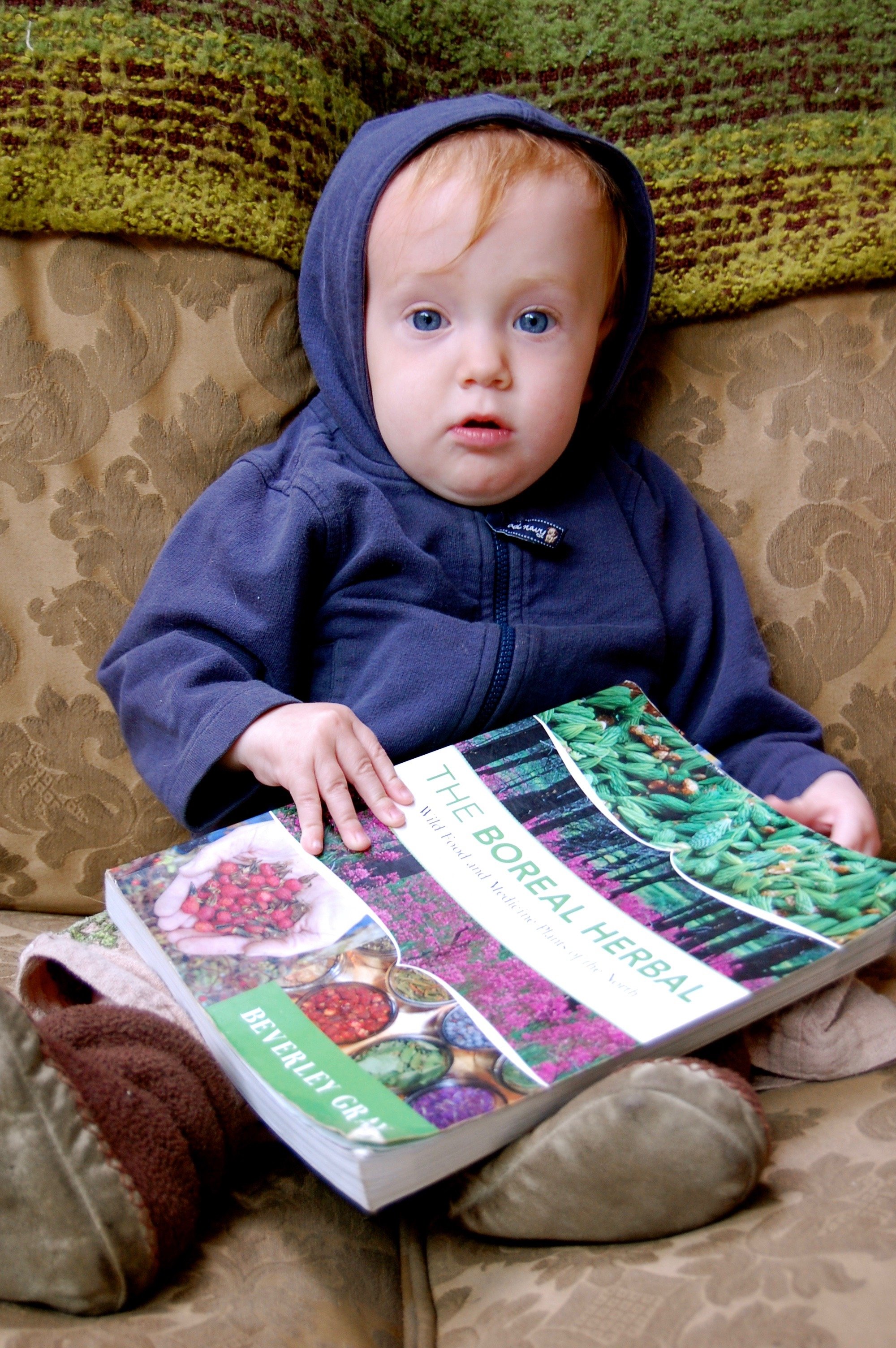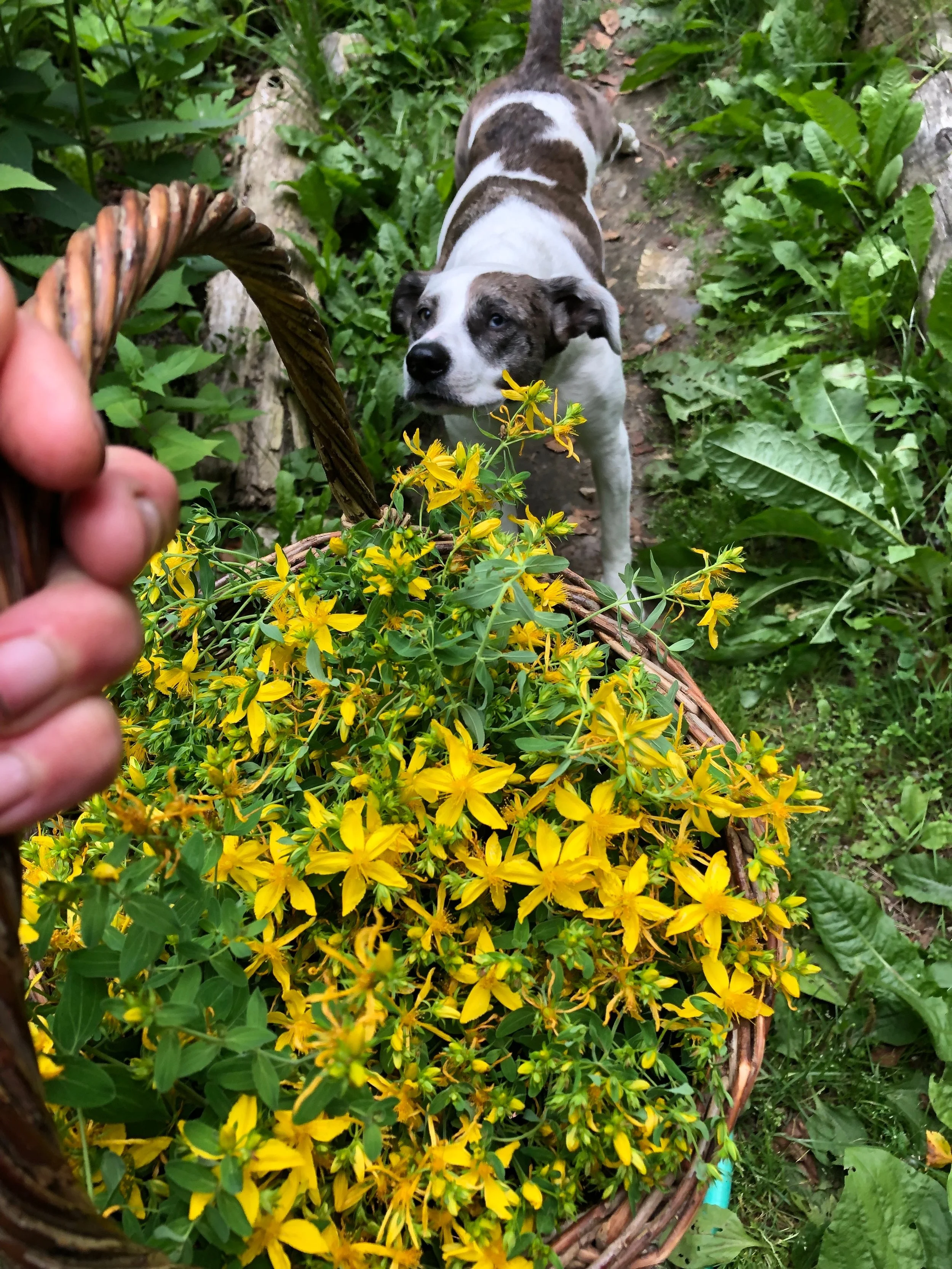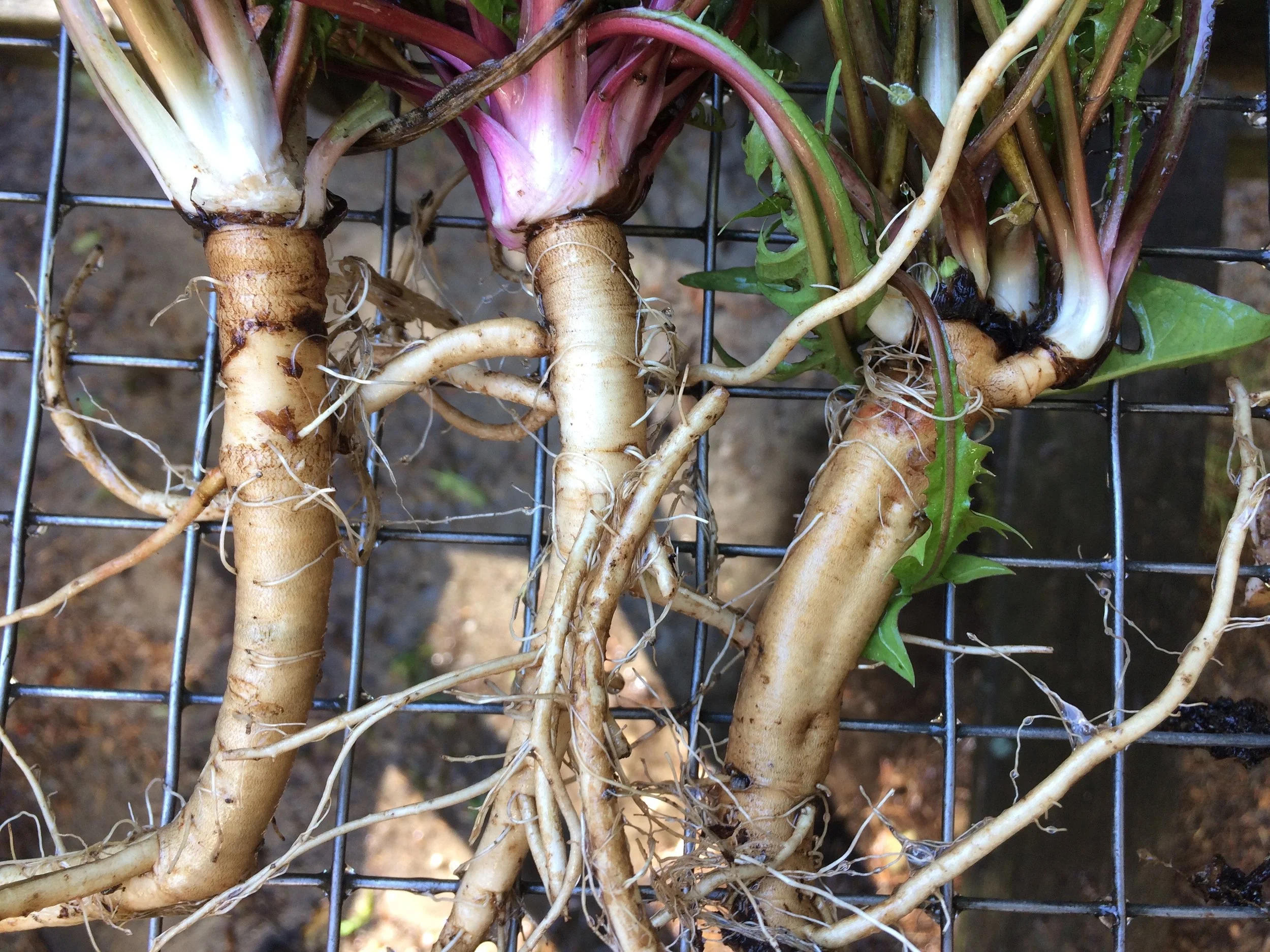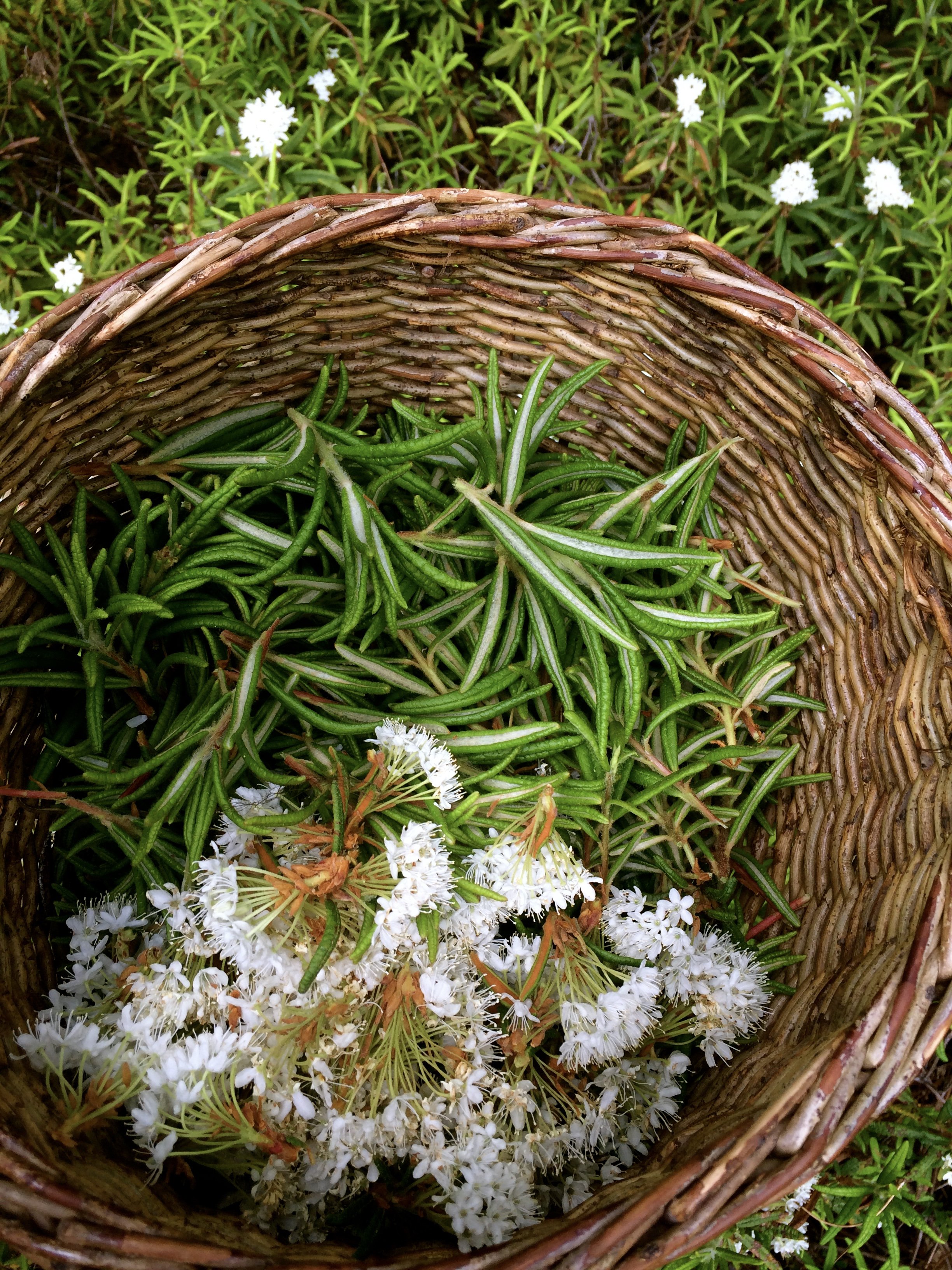Ethical Foraging
Harvesting Yarrow flowers with my daughter a few years ago.
Ethical foraging is also known as sustainable wild-crafting or ethical wild-harvesting. This occurs when you are paying attention to the land, giving reverence and gratitude and being aware of what is appropriate to harvest and what is not. Oftentimes, this is when you are foraging in places that are not your ‘own’ for example, not your own backyard garden or land, however these guidelines are useful for those harvests as well.
I’ve been tending and gathering from the wild lands around me since 2002 when I lived in SE Alaska. That is where I truly learned about bio-regional herbalism, in the great temperate rainforest of the Tongass. The lushness of that region, with all the moss, lichens and a vast variety of plant life, drew me in and changed my life. There are spirits in the forest and I felt that deeply right away. Plant spirits, animal spirits, land spirits. I was able to connect better when I was alone, I could ‘hear’ them when by myself. This is for the most part still true, however I’ve gotten better about being with others in the forest and still able to tap into that communication pathway.
Now I live in SE Idaho, a completely different bio-region to me (I grew up in the Northwoods of Wisconsin and spent 19 years in Alaska). It’s so much drier here, and while there are some familiar plants like Fireweed, Red Osier Dogwood, Cottonwood and Alder, there are many plants that are new like Arrow leafed Balsamroot, Oregon Grape root, Big Sagebrush, Hawthorn, Choke Cherry and Western Mugwort. The part of me that loves discovering new plant friends is excited as can be, and I try not to miss my Alaskan allies like Devil’s Club and High bush Cranberry to the point of grief (not always easy that one).
As an herbal medicine maker, it can get tricky when you’re on public lands or in a national forest. These are held in the public good, the right of all of us to tread upon these lands and enjoy the beauty, the scenery, the gifts of the Earth. It’s not appropriate to take too much, as that destroys the next person’s right to access, or the lands right to replenish and feed those nearby, whether soil health, insect, mammal or bird.
It is my belief however, that when humans connect and tend to the land, we intrinsically take better care of it. And that disconnect from Nature leads us to commodify it, put it in a box that can only be opened by a select few, and severs our connection from Source which is part of the reason we see so many problems in our society today. That connection to the land brings responsibility, and careful tending and knowledge about how we are interacting with the land is key.
This list of ethical foraging guidelines comes from my own experience of 20 years of wild gathering as well as learning from these influential plant teachers and medicine makers: Beverley Gray, Robert Rogers, Janice Schofield, and Rosalee de la Foret. (You can find links to their work in the Resources section of this webpage). There are many others from whom I’ve found valuable information, but these four and my own personal encounters and connections with plants were the primary sources for learning what I share below.
Without further ado, here we go….
Archaic Joy’s Ethical Foraging Guidelines
1. Observe, observe, observe
Truthfully, having dogs made me a wiser wild forager/harvester. And the reason why, is that they were happier when they were walked daily. So, I hiked around the forests surrounding nearly every day, through all kinds of weather, throughout the year. And I began to see patterns, cycles of the season. I noticed what plants grew in the moist understory of Spruce, Hemlock and Fir, what plants grew in the meadows and along the seashore. Were they abundant? Were they abundant regionally or just locally?
For example, after 5 years of living in Skagway I found a wild Stinging Nettle patch, literally right off of a pathway. A year or two later, I came across some scattered Nettles in another area, a few miles away and then a year or two later, my dear neighbor Nan shared that she had some growing in the hedge space between her yard and the forest. In Juneau, I’ve listened to gatherers describe great swaths of Nettles in areas. Not so in Skagway. Hence, I did what gardeners do best and took some cuttings, rooted them in water and planted them in my own garden. I harvested sparingly from the original patch I had found as it was decent sized and well established and I could tell that no one else had been there. That’s the other part of it: be aware of other foragers in the area by looking for harvest marks, cuttings or disturbed ground. Now, the thing is this too, as an ethical forager you shouldn’t be able to easily see that you’ve harvested, so this takes keen eyesight and an ability to read the landscape in order to see if someone else has been where you are.
I think it’s incredibly important to walk the land for some time, getting to know the trees, getting to know the plants, talking to them (whether aloud or in your head, I do both), asking them questions, giving gratitude for their beauty and place within the wild, and taking photos (or drawing if you’re good at that) in order to properly identify later if you’re uncertain who someone is. That’s why, when I moved to Idaho this past summer, I didn’t harvest anything for several months. Well, aside from Huckleberries, but even those I didn’t take more than a couple of quarts since I was new to the area.
So, observe who grows around you first and foremost. Are they abundant? Is it regionally or locally so?
2. Proper Identification
This is super important. You want to make sure what you are foraging, whether edible or medicinal, is what you think it is. Now days there are many excellent plant ID guides. For the northern regions I highly recommend The Boreal Herbal by Beverley Gray and Discovering Wild Plants by Janice Schofield (these are also wonderful medicine making handbooks). Jim Pojar and Andy MacKinnon (with others) offer plant guides for many regions as well and I also recommend their works. Often you can find local/regional writers as well, and cross referencing is imperative. I have books with pictures, and some with drawings only, there is value in both. What a photo looks like in one book can imitate a similar species, for example, Split Lip Hemp Nettle and Stinging Nettle look very similar before flowering, but are in fact entirely different plants. Attending local plant walks and workshops held by plant aficionados is very beneficial. There are many online resources, but personally, I prefer books! When I worked at Jewell Gardens I had an employee with an app on his phone that identified plants; there were several instances when it was helpful, however, there were many that were incorrect. Don’t rely on a single resource, cross reference! Continually, this is the practice of observation as well. What does a plant look like in spring, in summer and autumn, and in winter as well? Is it a perennial, biennial or annual? These are important questions to answer.
One of my favorite plant guides: The Boreal Herbal by Beverley Gray
3. Awareness of the Ideal Time to Harvest
This is where timing is everything. If you harvest a Dandelion root in the heat of summer while the plant is in flower, your medicine, your food, will not be as potent or taste as good; in fact, with the Dandelion, it’ll be downright dismal. Roots are best harvested in the early spring and mid to late autumn depending. Flowers are best harvested when the dew is off and the heat of the day has yet to arrive. You also want to be sure that you leave, enough blooms for the plant to reseed and some for the bees and other insects that may also be vying for those pretty blooms. When picking Rose petals, Bev Gray taught me that if you leave a couple of petals on the wild Rose flower, the bees can still pollinate and the Rose hip can still form. This is by far better than taking all the petals, or the entire bud. That said, taking a few buds from an abundant patch won’t harm its ability to reproduce. Leaves, for the most part, are better when younger and before flowering. There are always exceptions to the rule and as you go along, you’ll find these out. I think of Comfrey in this regard; harvesting leaves while the plant is in flower (before they seed and before a frost though!) still yields good medicine.
St. John’s Wort (Hypericum perforatum) harvested on a dry day and in full bloom, from my former backyard AK garden. And Pepper dog.
4. Asking Permission & Reciprocity/Giving Gratitude
Now you’ve gone through the above guidelines and you’re ready to forage or wild harvest. You’ve got your basket or paper bags, some clippers or scissors and the day open to magic. But before you cut or dig you need to, first, ask permission! And yes, I do mean this literally. It can be spoken out loud, or within your mind…”Is it okay if I harvest you?” “My friend is feeling poorly; may I take some of your blossoms Yarrow?” “I’d like to make smudge stick with you Sagebrush, may I?” “You are powerful and sacred; may I share some of your medicine?” are all examples of asking permission of the plant. I like to find the ‘grandmother’ or ‘grandfather’ of a patch and ask as well as the individual plant. And then listen. Sometimes it’s not verbally ‘heard’ but more of a nudge or gentle feeling towards or away from the plant. Sometimes I literally hear, “no.” Other times, it’s a “yes, of course.”
Being in a calm state of mind with good and clear intentions of what you are planning will facilitate this process. And then give thanks. This can be a simple “Thank You.” It can also be a gift of a pretty stone, a piece of your hair, a song, or a prayer. It can be pulling off a fallen branch that is inhibiting their growth, picking up any garbage that was left in the area (that’s a good thing to do regardless of whether or not you’re actively harvesting). If you’re near a stream you could gather water and give it to those thirsty plants nearby. You could clip off the dead branches to encourage air flow (know what you’re doing beforehand of course, this comes with time and experience). Humans have evolved with Nature. We are of Nature, and tending to the Plants is something we’ve done for ages; it sometimes just takes some time and guidance to remember how to be human on the face of this earth. If hearing what the plants are saying is difficult for you, spend more time with them. It will come.
5. Know how Much to Gather
When I was first starting out, a rule of thumb I often saw stated was: “Never take more than a 1/3 of a patch or a plant.” This can also go for pruning in the garden. In my opinion, this is too much as far as wild harvesting goes. If for example, you harvest 1/3 of all the Devil’s Club buds in a patch, that leaves 33% of that area without leaves! Not appropriate harvesting at all. (In the case of Devil’s Club buds, I used to eat only 1-3 in the springtime as a special spring welcome, because I knew how large the leaf spread was and how important it is for the plant to gather sunlight.) I don’t really have a numerical ratio that I use, but if I had to give one, I’d say a 1/10 would be more in line with ethical foraging. And you need to move around as well. This is where it’s important to know the landscape and what’s abundant and what’s not. Here, there is a ton of big Sagebrush and I imagine that many local folks would think nothing of cutting off whatever it is they wanted from that plant since it’s so ubiquitous in the area. However, this plant takes a looong time to grow and is difficult to regenerate when removed from a place. So being mindful of these factors lends one to move from plant to plant, from patch to patch. Only taking a bit here and there. Another factor is your Time. Generally, it takes 2/3 more time to properly clean, dry, process and store your harvest than the actual time it takes to gather. So, keep that in mind! Only gather what you realistically have time to deal with. Note: mushrooms and garden plants that you are growing specifically to harvest are a bit different and that 1/10 rule is not necessarily valid when it comes to that.
6. Cleaning, Drying, Processing your Harvest
Again, this is where the plant books come in handy (see the Resources section for more!). Whether you’re gathering Dandelion roots, Cleavers, wild Raspberry leaf or Willow bark, you need to know what you’re going to be doing with it before you go and gather. Are you making a fresh plant tincture? Are you drying for tea? Sautéing for dinner? Infusing into an oil? What you plan to make with what you gather will depend on how you process your harvest. If it’s Morel mushrooms, all you need to do is chop and heat. If it’s Raspberry leaves you need to make sure you’re using super fresh or all the way dried (both Raspberry and Strawberry leaves shouldn’t be used internally during the intermediate wilting/drying stage). Do you have proper ventilation and a spot out of direct sunlight for drying plants? A scrubber for getting the dirt off?
There are too many factors to describe here, but the point is, know what you’re planning to do before you harvest and make sure you have the tools and space to properly deal with them when you return from gathering. And when you get back home, don’t let the plants sit in bags or in a basket in a hot vehicle. Treat the plants (or mushrooms) reverently and your food and medicine will be so much better. Now there will probably be times when you harvest something and it languishes too long because your kid got sick or something came up unexpectedly. Use it as a learning experience. Apologize to the plants, they really do understand our intentions and keeping good lines of communication matters.
Freshly cleaned Dandelion roots. Outside with a hose sprayer works well and keeps the dirt where it belongs, outside, and not down your drain!
7. Labeling & Shelf Life
Be sure to label any jars of tinctures, oils, dried plant matter!! Seriously, even now, I always label with the plant name (Latin too if I’m feeling inclined), date and any other ingredients when I jar something up. The “oh, I’ll remember” can stump even the best among us. Trust me on this one! And then USE IT. Know how long your tea, tincture or oil ‘should’ be stored for and in what conditions, and treat yourself and the plants well by actually using, or sharing, what you’ve gathered. Again, there are so many variables on storage and length of effectiveness, that to list them all here would add another 50 pages. There are many medicinal plant making guides that will help you figure this out, again, check out the Resource section on this website or reach out for a private 1:1 session where I can help you find resources specific to your region and answer questions you may have about beginning your journey into ethical foraging.
A rainbow of jarred and labeled herbs.
Feel free to share this with friends or family. If you have any comments, please leave below. And happy harvesting friends. The world needs more people who are tending the wild lands than ever before. Take good care of this earth, she is the source of life, the source of us. Be well. And gather with grace.
XO
Emily Grace
Labrador Tea (Rhododendron groenlandicum)





